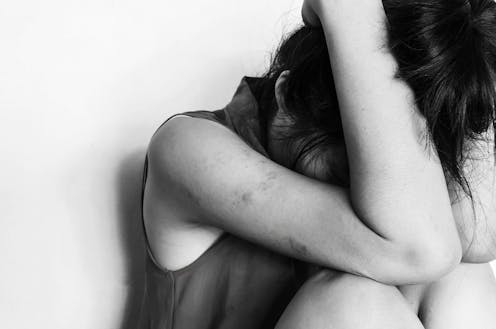First Nations women are 69 times more likely to have a head injury after being assaulted. We show how hard it is to get help
- Written by Michelle Fitts, ARC DECRA Fellow, Institute for Culture and Society, Western Sydney University

First Nations people, please be advised that the following article mentions family violence and assault.
Aboriginal and Torres Strait Islander women are 69 times more likely than non-First Nations women to go to hospital with a head injury because of an assault.
But not all First Nations women get the support they need.
Our new study shows how health and support services working in remote areas are not equipped with the tools to identify the potential of a head injury for women who experience violence.
Not only are service workers not asking women about a potential traumatic brain injury, there’s a lack of referral options, and often no diagnosis, limiting women’s access to services and supports for recovery.
Read more: Four Corners' 'How many more?' reveals the nation's crisis of Indigenous women missing and murdered
What is traumatic brain injury?
Head injuries after an assault range from cuts and bruises to the type that can cause longer-term damage, known as traumatic brain injury.
Traumatic brain injury is defined as damage to, or alteration of, brain function due to a blow or force to the head. Non-fatal strangulation can also lead to brain injury as the brain is deprived of oxygen.
Such injury can have short-term (acute) effects or cumulative effects (over months or years). Changes vary from person to person but can include memory loss, difficulty with motivation, impaired awareness, sensory problems, mood changes and anxiety.
Some types of traumatic brain injury are also a risk factor for early onset dementia.
Read more: Explainer: what is traumatic brain injury?
We’re talking about family violence
Our work tries to understand the needs and priorities of First Nations women who have experienced a traumatic brain injury due to family violence.
Timely and culturally safe care, and support, following such brain injury is vital. But not all First Nations women get access to it.
So, in early 2022, we spoke to 38 professionals from various sectors – including health, crisis accommodation and support, disability, family violence, and legal services – working across remote areas of the Northern Territory.
The data offers insights into the barriers that can prevent people asking First Nations women about possible brain injury, and women’s access to health care afterwards.
Read more: Aboriginal Australians want care after brain injury. But it must consider their cultural needs
Often, there’s no follow-up
Participants told us that while the more severe cases were evacuated from a remote community to a hospital, less-severe cases were not always followed up.
One participant told us:
Women are often not evac-ed out following a head injury, if it’s assessed to not be an urgent thing, so might not necessarily be getting CT scans.
CT scans can help inform diagnosis, treatment and support.
Service providers were also often unaware of follow-up pathways to identify and connect women with the right supports, should they have ongoing symptoms.
A fly-in, fly out workforce
Participants told us that high workforce turnover and fly-in, fly-out health services in remote regions could also affect identification of traumatic brain injury.
They told us short-term staff can lack knowledge and familiarity of working in remote communities, and in building community relationships.
Read more: Fly-in, fly-out heath care fails remote Aboriginal communities
Lack of referral, diagnosis, training
Not all women were referred to neuropsychologists (health professionals who might assess symptoms), which led to gaps in medical reports and formalised assessments. One participant told us:
I don’t know any who actually have a confirmed diagnosis.
This has implications for how women are managed and the supports they receive.
None of the staff we interviewed had completed training about traumatic brain injury. One told us:
We get ADD [attention-deficit disorder] workshops, we get domestic and family violence workshops, disability support workshops, but nothing around brain injury.
Other than some legal services, service providers did not ask specific questions of women who had experience violence and assaults about possible traumatic brain injury.
One participant said:
We’ll screen for domestic violence, but we don’t screen for specific injuries.
What can we do about it?
As our research shows, First Nations women with traumatic brain injury need better access to support and services, which is critical for their long-term recovery.
Here’s how we support frontline staff:
design and roll out education about traumatic brain injury to develop staff knowledge and confidence. This education needs to be tailored to the type of frontline staff (remote area nurses will clearly need different education to housing staff), be designed with First Nations input and be culturally appropriate
ask women about the possibility of traumatic brain injury as part of existing family violence and health assessments
ask culturally appropriate questions that are not meant to diagnose traumatic brain injury, but help to identify cognitive impairment and complex disability
explore different ways of delivering rehabilitation for mild traumatic brain injury, and whether telehealth might be appropriate under some circumstances.
Giving a voice to First Nations women living with traumatic brain injury is also crucial to providing the necessary supports during their rehabilitation and recovery.
If this article raises issues for you or someone you know, contact 1800 RESPECT (1800 737 732) or 13YARN (13 92 76). In an emergency, call 000.
Dr Gail Kingston (Townsville Hospital and Health Service) and Elaine Wills (Western Sydney University and Menzies School of Health Research) are co-authors of the journal paper on which this article is based. The authors would like to thank members of the project advisory group and all participants who shared their time and knowledge.
Authors: Michelle Fitts, ARC DECRA Fellow, Institute for Culture and Society, Western Sydney University



